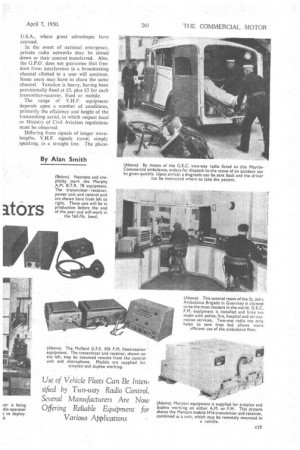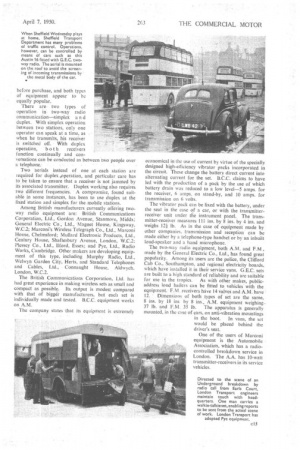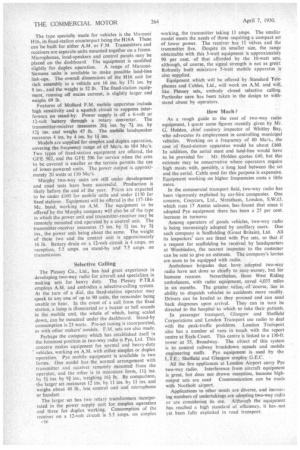Calling All Op Itors
Page 48

Page 49

Page 50

Page 51

Page 52

If you've noticed an error in this article please click here to report it so we can fix it.
By Alan Smith
HE telephone changed business methods.Twoway radio may produce an even greater alteration in commercial and industrial systems CI its use becomes as general. Its employment by the Forces, police, fire brigades and some ambulance services is essential, and where it has been adopted by commercial undertakings, including bus concerns, car-hire operatorS and C-licensees, the question-asked after a period of use has been: "How did we manage without it?"
At least six British manufacturers are now selling twoway radio equipment, and other well-known makers will be placing their products on the market soon. Transport operators would be wise to consult the manufacturers when exploring the possibilities 'of applying two-way radio to their own organizations. The nature of some undertakings would make its use an extravagance, and as reputable radio makers have names to keep, they would not be likely to advise the adoption of two-way radio in such cittumstances.
Nevertheless; the value of the equipment cannot be measured solely . in terms of money saving, for the invisible advantages of direct contact between executives and staff on outside work arc great. The value of the telephone can hardly be reckoned in terms of money. St. Martin's le Grand, London, E.C.1, the G.P.O. states that radio channels for private radio telephone services are available where "line or other methods of communication would not be reasonably .adequate."
Connection of private radio services to the public telephone network is not permitted. This is thought by some people to be an obstacle in the path of full develop: rnent of two-way radio. Such a link-up is made in the
but only by the, yardstick of efficiency. That applies also ' to two-way radio, which many companies have adopted, not so much to save time and expense and cut out waste, as to improve service.
Frequencies allotted to commercial and municipal transport users by the General Post Office are in the 80and 160-megacycle V.H.F. (very high frequency) bands. In its memoranda on the subject, which may be obtained from the Overseas Telecommunications Department, G.P.O.,
U.S.A., where great advantages have accrued.
In the event of national emergency, private radio networks may he closed down or their control transferred. Also, the G.P.O. does not guarantee that freedom from interference in a broadcasting channel allotted to a user will continue. Some users may have to share the same channel. Taxation is heavy, having been provisionally fixed at ES, plus 1.5 for each transmitter-receiver, fixed or mobile.
The range of VHF. equipnitent depends upon a number of conditions, primarily the efficiency and height of the transmitting aerial, in which respect local or Ministry of Civil Aviation regulations must be observed.
Differing from signals of longer wavelengths, V.H.F. signals travel, simply speaking, in a straight line. The places
where they can be received are those •which a person could see from the top of the aerial. Signals could be picked up in some places beyond the horizon or hidden from the eye by hilltops, for instance, because of the tendency of the earth to attract radio waves. Signals normally exceed the "line of sight" by 20 to 30 per cent. The higher the aerial the greater the range, the ideal position for a transmitter being on a hill with open country around. if only a few square miles have to be
covered, the requirements in selecting a site are less stringent.
In ideal circumstances, signals may be picked up by a vehicle up to about 40 miles, to quote one manufacturer, although in theory greater distances are possible. Such a radius of operation is, however, hardly practicable. Post Office authorities may incline to think that it is too big, frowning upon ranges over 15 miles, and users may find it conflicting with another service. If the point from which the station is to be operated be not a suitable site for the aerial, this can be erected away from the control point with connection by land line, or by radio link up to about 15 miles.
There are two types of equipment made for twoway radio communication, working on either amplitude modulation (A.M.) or frequency modulation Most domestic radio sets work on A.M., in which the c14 amplitude of the signal varies in accordance with its strength, the frequency remaining constant.
With F.M. equipment, a recent development, the amplitude of the signal remains constant, but its frequency varies with the strength of the signal. An A.M. signal on a frequency of 85 Mc/s. would lie in a channel 30 Kc/s. wide to allow for transmission variations, the greater bandwidth for an 85-Mc. F.M. signal being 60 Kc/s., to allow for the alterations in frequency which are implicit in its operation and frequency drift. Such an F.M. signal would vary between ±15 Kc/s.
Although F.M. equipment is at present more expensive than A.M., its transmissions are usually far less liable to electrical interference. Urban traffic sometimes causes distracting background crackle on A.M. receivers, and faint speech reception may be drowned.
Screening, or the blocking of the path of a signal by buildings and so on, also makes for poor reception. Obstacles " shadow " areas, and weaken and sometimes completely diminish receptivity. Both A.M. and F.M. transmissions are affected equally by screening. The
higher the frequency of a signal the more the range is reduced by it. On the other hand, the higher the fre
quency, the less liable it is to electrical interference.
F.M. transmissions continue to the limit of their determined range at constant strength, but then end abruptly.
By comparison, A.M. signals spread out endlessly like ripples on a pond, gradually diminishing in strength, and are capable of being received over long distances.
The question. A.M. or F.M.? has faced many users before purchase, and both types of equipment appear to be equally popular.
There are two types of operation in two-way radio communication—simplex a n d duplex. With simplex operation between two stations, only one operator can speak at a time, as when he transmits, his receiver is switched off. With duplex operation, both receivers function continually and conversations can be conducted as between two people over
a telephone: • Two 'aerials instead of one at each station are required for duplex ,operation, and particular care has to be taken to ensure that a receiver is not jammed by its associated transmitter. Duplex working also requires two different frequencies. A compromise, found suitable in some instances, has been to use duplex at the fixed 'station and simplex for the mobile stations.
Among British manufacturers currently offering twoway radio equipment are: British Communications Corporation, Ltd., Gordon Avenue, Stanrnore, Middx; General Electric Co.; Ltd., Magnet House, Kingsway, W.C.2; Marconi's Wireless Telegraph Co., Ltd., Marconi House, Chelmsford; Mullard Electronic Products, Ltd., Century House, Shaftesbury Avenue, London, W.C.2; Plessey Co., Ltd., Ilford., Essex; and Pye, Ltd., Radio Works, Cambridge. Other makers are developing equipment of this type, including Murphy Radio, Ltd., Welwyn Garden City, Herts, and Standard Telephones and Cables, Ltd., Connaught House, Aidwych. London, W.C.2.
The British Communications Corporation, Ltd. has had great experience in making wireless sets as small and compact as possible. Its output is modest compared with that of bigger manufacturers, but each set is individually made and tested. B.C.C. equipment works on A.M.
The company states that its equipment is extremely
economical in the use of current by virtue of the specially designed high-efficiency vibrator packs incorporated in the circuit. These change the battery direct current into alternating current for the set. B.C.C. claims to have led with the production of a pack by the use of which battery drain was reduced to a low level-5 amps. for the receiver, 6 amps. on stand-by, and 10 amps. for transmission on 6 volts.
The vibrator pack can be fixed with the battery, under the seat in the case of a car, or with the transmitterreceiver unit under the instrument panel. The transmitter-receiver measures 1l ins. by 8 ins. by 4 ins, and weighs 12i lb. As in the case of equipment made by other companies, transmission and reception can be made either by a telephone-type handset or by an inbuilt loud-speaker and a hand microphone.
The. two-way radio equipment, both A.M. and F.M , made by the General Electric Co., Ltd., has found great popularity. Among its users are the police, the Clifford Cab Co., Southampton, and regional electricity boards, which have installed it in their service vans. G.E.C. sets are built to-a high standard of reliability and are suitable for use iu the tropics. As with other makes, publicaddress loud ha ilcrs can be fitted to Vehicles with the equipment. F.M. receivers have 14 valves and A.M. have 12. Dimensions of both types of set are the same, 8 ins. by 18 ins by 8 ins., A.M. equipment weighing 37 lb. and F.M. 35 lb. The apparatus is generally mounted, in the case of cars, on anti-vibration mountings
in the boot. In vans, the set would be placed behind the driver's seat.
One of the users of Marconi equipment is the Automobile Association, which has a radiocontrolled breakdown service in London. The A.A. has 10-watt transmitter-receivers in its service vehicles. The type specially made for vehicles is the Marconi H16, its fixed-station counterpart being the HI6A These can 'be built for either A.M. or F.M.Transmitters and receivers are separate units mounted together on a frame. Microphones, loud-speakers and control panels may be placed on the dashboard. The equipment is modified
slightly for duplex operation. A range of MarconiSiemens units is available to make possible land-line link-ups. The overall dimensions of the H16 unit for rack assembly in a vehicle are 16 ins, by 17: ins. by 8 ins., and the weight is 32 lb. The fixed-station equipment, running off mains current, is slightly larger and weighs 69 lb.
Features of Mullard F.M. mobile apparatus include high sensitivity and a squelch circuit to suppress interference on stand-by. Power supply is off a 6-volt or 12-volt battery through a rotary converter. The transmitter-receiver measures 26i ins. by 7i ins. by 124 ins, and weighs '47 lb. The mobile loudspeaker measures 4 ins. by 4 ins. by 1/ ins.
Models are supplied for simplex and duplex operation, covering the frequency range of 65 Mc/s. to 184 Mc/s. Two types of fixed-station equipment are offered, the GFE 502, and the GFE 506 for service when the area to be covered is smaller or the terrain permits the use of lower-powered units. The power output is approximately 20 Watts at 110 Mc/s.
Murphy two-way units are stilt under development and road tests have been successful. Production is likely before the end of the year. Prices are expected to be under £100 for mobile units and under £150 for fixed stations. Equipment will be offered in the 157-184Mc. band, working on A.M. The equipment to be offered'by the Murphy company will also be of the type in which the power unit and transmitter-receiver may be remotely mounted and operated by a control unit. The transmitter-receiver measures 13 ins. by 51 ins. by 3i ins., the power unit being about the same. The weight of these two and the control unit is approximately 16 lb. Battery drain on a 12-volt circuit is 4 amps. on reception, 5.5 amps. on stand-by and 7.5 amps. on transmission.
Selective Calling The Plessey Co., Ltd., has had great experience in developing two-way radio for aircraft and specializes in making sets for heavy duty. The Plessey P.TR.6 employs A.M. and embodies a selective-calling system. At the turn of a dial, the fixed-station operator may speak to any one of LID to 90 units, the remainder being unable to hear. In the event of a call from the fixed station, a lamp is illuminated or a buzzer or bell sounds in the mobile unit, the whole of which, being scaled down, can be mounted under the dashboard. Stand-by consumption is 23 watts. Pre-set tuning is incorporated, as with other makers' models. F.M. sets are also made.
Perhaps the company which has established itself in the foremost position in two-way radio is Pye, Ltd. This concern makes equipment for normal and heavy-duty vehicles, working on A.M. with either simplex or duplex operation. Pye mobile equipment is available in two forms. One model has the normal arrangement with transmitter and recz,Liver remotely mounted from the operator, and the other is in miniature form, 1l ins. by 51 ins. by 91 ins., weighing 16± lb. By comparison, the larger set measures 12 ins. by 11 ins. by 11 ins, and weighs about 40 lb., less control unit and microphone or handset.
The larger set has two rotary transformers incorporated in the power supply unit for simplex operation and three for duplex working. Consumption of the receiver on a 12-volt circuit is 5.5 amps. on simplex el6 working, the transmitter taking 13 amps. The smaller model meets the needs of those requiring a compact set of lower power. The receiver has 11 valves and the transmitter five. Despite its smaller size, the range obtainable with this 3-watt equipment is approximately 90 per cent, of that afforded by the 10-watt sets, although, of course, the signal strength is not as great: Robustly built miniature 5-watt mobile apparatus is also supplied.
Equipment which will be offered by Standard Telephones and Cables. Ltd., will work on A.M. and will, like Plessey sets, embody closed selective calling. Particular care has been taken in the design to withstand abuse by operators.
How Much ?
As a rough guide to the cost of two-way radio equipment, I quote some figures recently given by Mr.
G. Holden, chief sanitary inspector of Whitley Bay, who advocates its employment in controlling municipal vehicles. Working on a frequency of 80 Mc/s., the cost of fixed-station apparatus would be about £160.
In addition, the aerial mast and land-line would have to be provided for Mr. Holden quotes £40, but this estimate may be conservative where operators require high masts with, possibly, a long lead between the set and the aerial. Cable used for this purpose is expensive. Equipment working on higher frequencies costs a little more.
In the commercial transport field, two-way radio has been vigorously exploited by car-hire companies. One concern, Cosycars, Ltd., Streatham, London, S.W;15, which runs 17 Austin saloons, has found that since it adopted Pye equipment there has been a 25 per cent. increase in turnovel Among operators of goods vehicles, two-way radio is being increasingly adopted by ancillary users. One such company is Scaffolding (Great Britain), Ltd. All its inspectors' cars are fitted with Pye sets, so that if a request for scaffolding be received by headquarters at Wimbledon, the nearest inspector to the customer can be sent to give an estimate. The company's lorries are soon to be equipped with radio.
Ambulance brigades that have adopted two-way radio have not done so chiefly to save money, but for humane reasons. Nevertheless, three West Riding ambulances, with radio equipment, .saved 4,035 miles in six months. The greater. value, of:Course, lies in ability to dispatch vehicles to accidents more readily.
Drivers can be briefed as they proceed and can send back diagnoses upon arrival. They can in turn be directed to the hospital to which to take their patients.
In passenger transport, Glasgow and Sheffield Corporations and London Transport use radio to deal with the peak-traffic problems. London Transport also has a number of vans in touch with the report centre at Earls Court. This centre is linked to a 130-ft.
tower at 55, Broadway. The object of this system is to control railway breakdown squads and mobile engineering staffs. Pye equipment is used by -the L.T.E.; Sheffield and Glasgow employ G.E.C.
All the fire appliances at London Airport carry Pye two-way radio. interference from aircraft equipment is great, but noes not drown reception, because highoutput sets are used Communication can be made with Northolt airport.
Applications to other needs are diverse, and increasing numbers of undertakings are adopting two-way radio or are considering its use. Although the equipment has reached a high standard of efficiency, it has ,not yet been fully exploited in road transport.
































































































